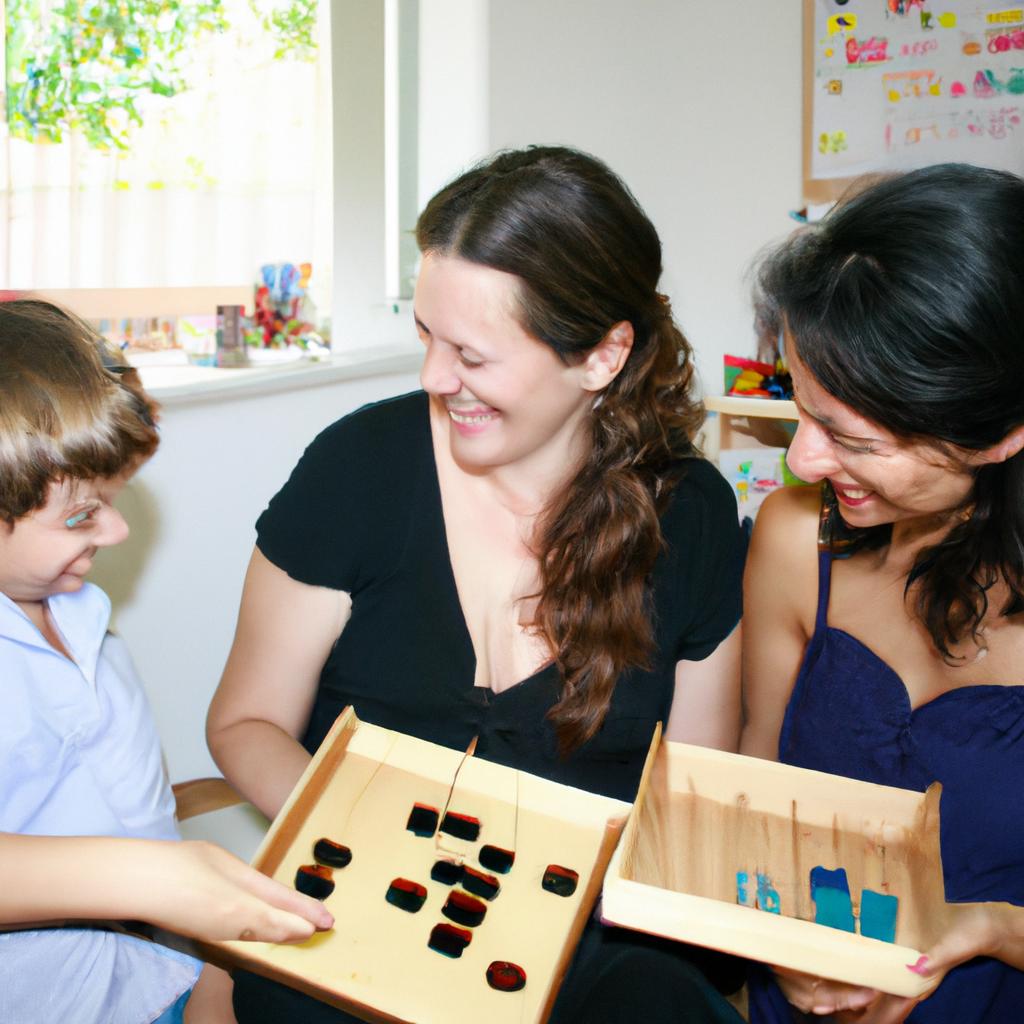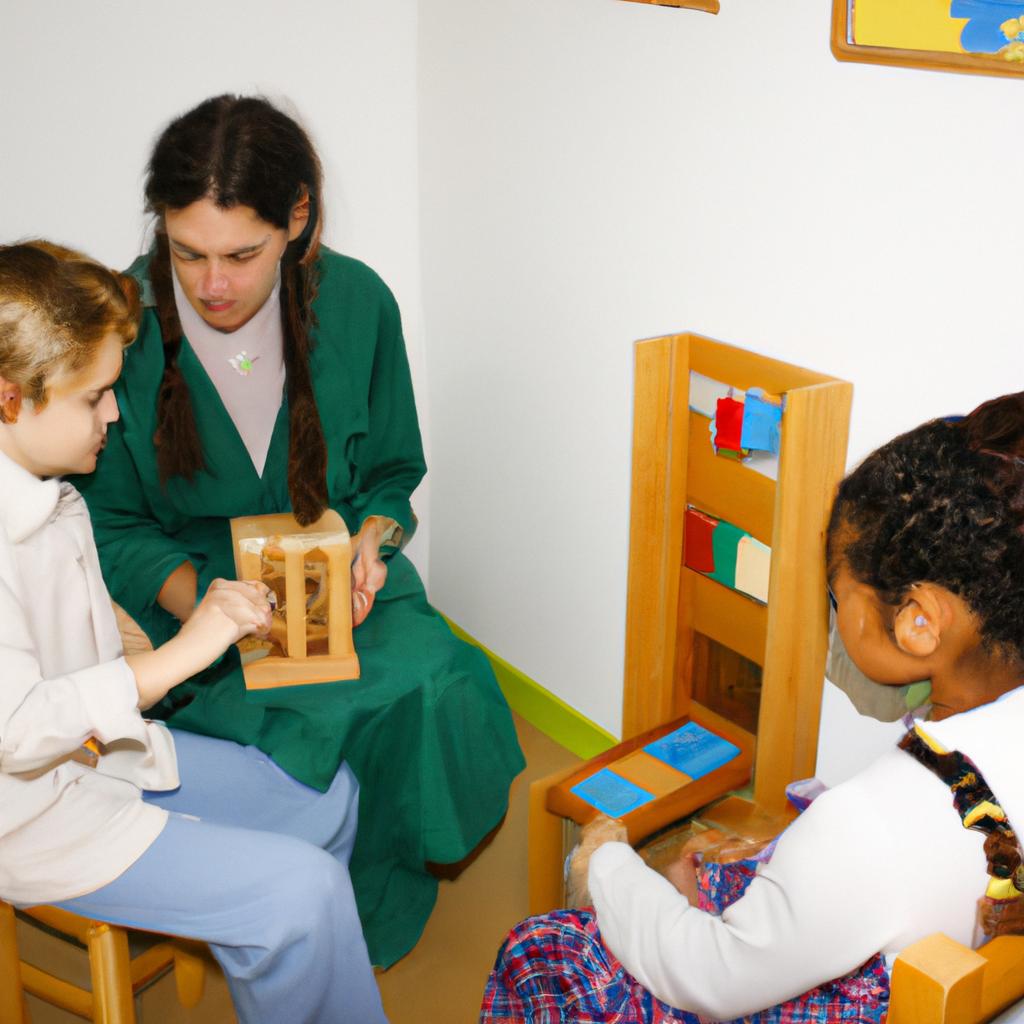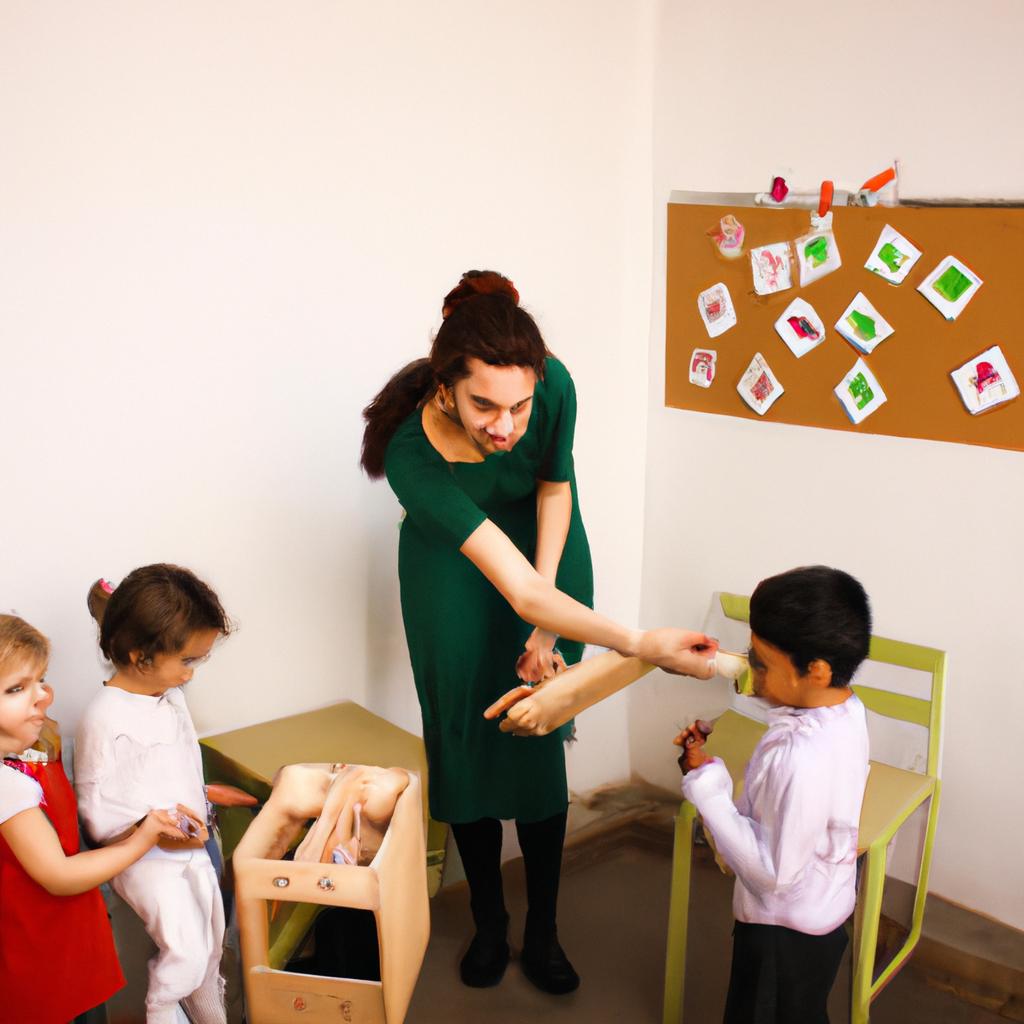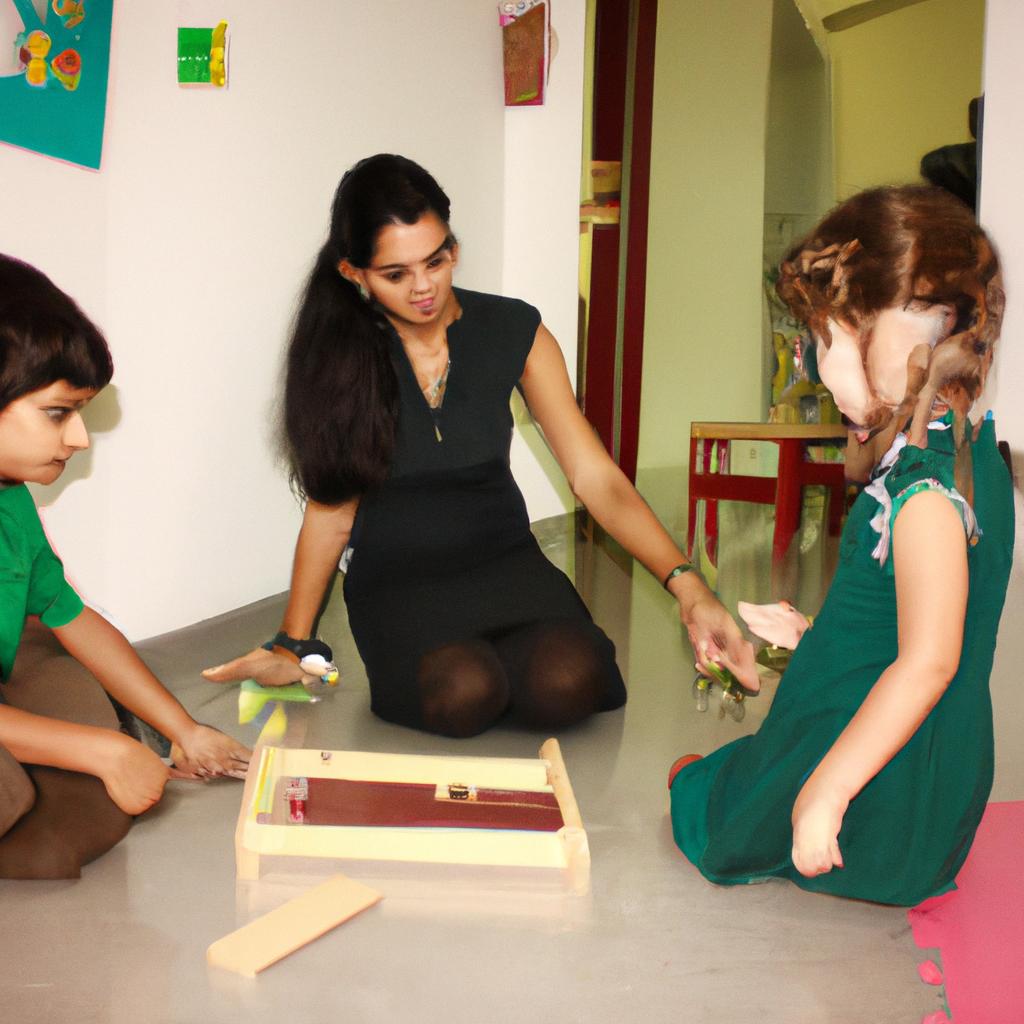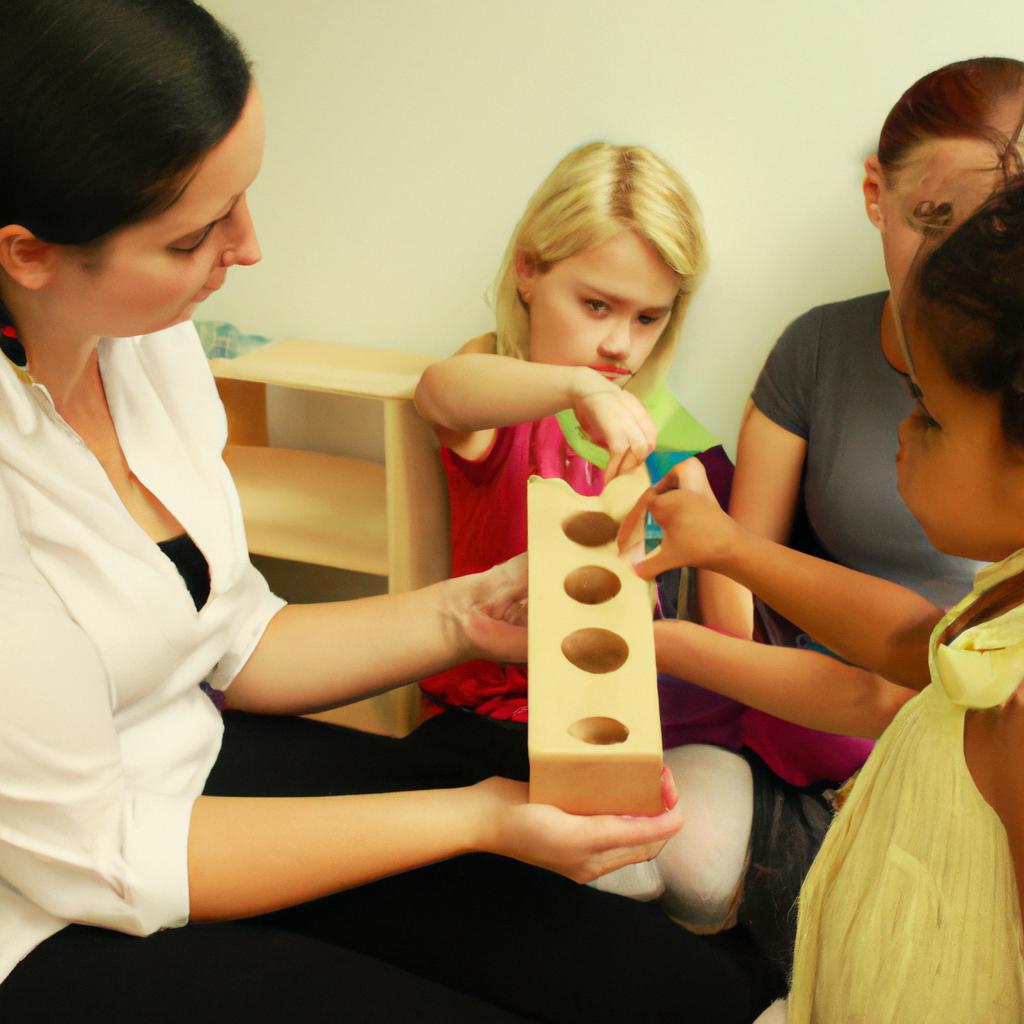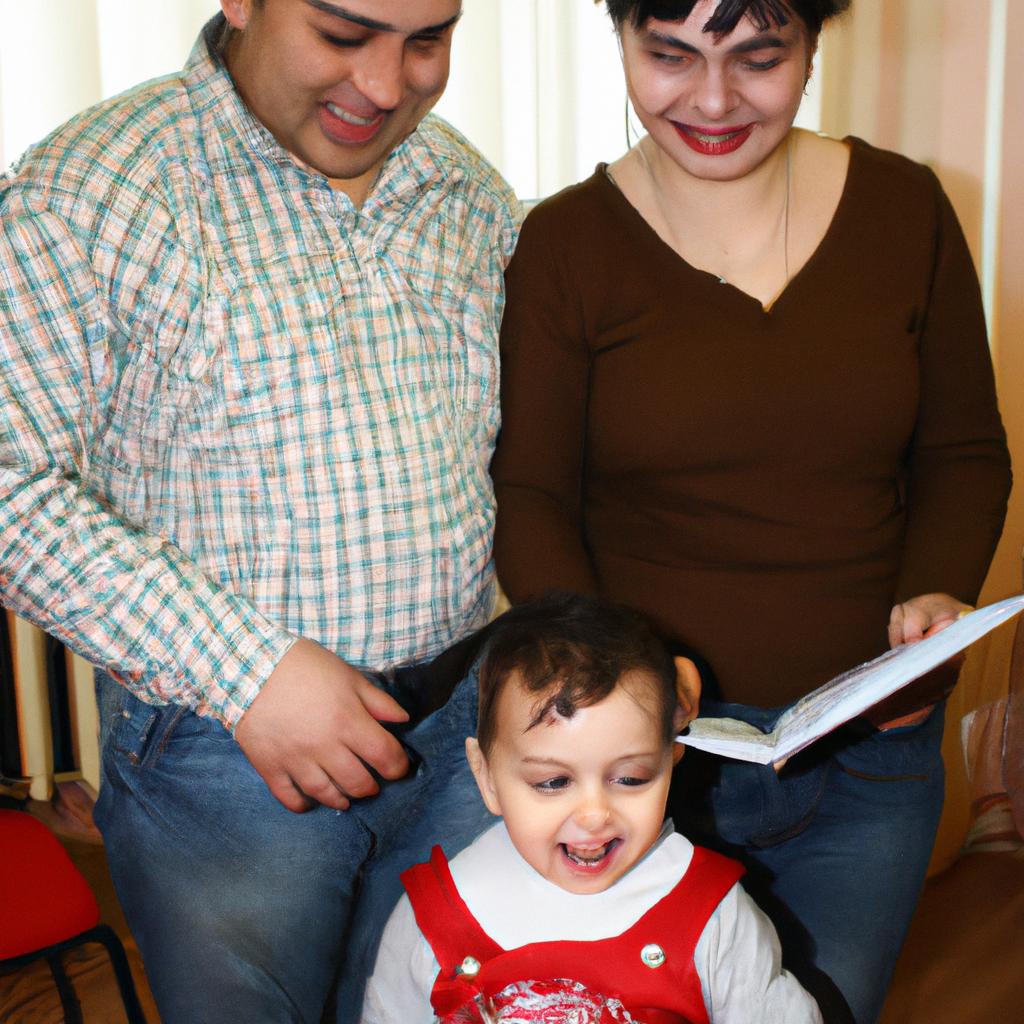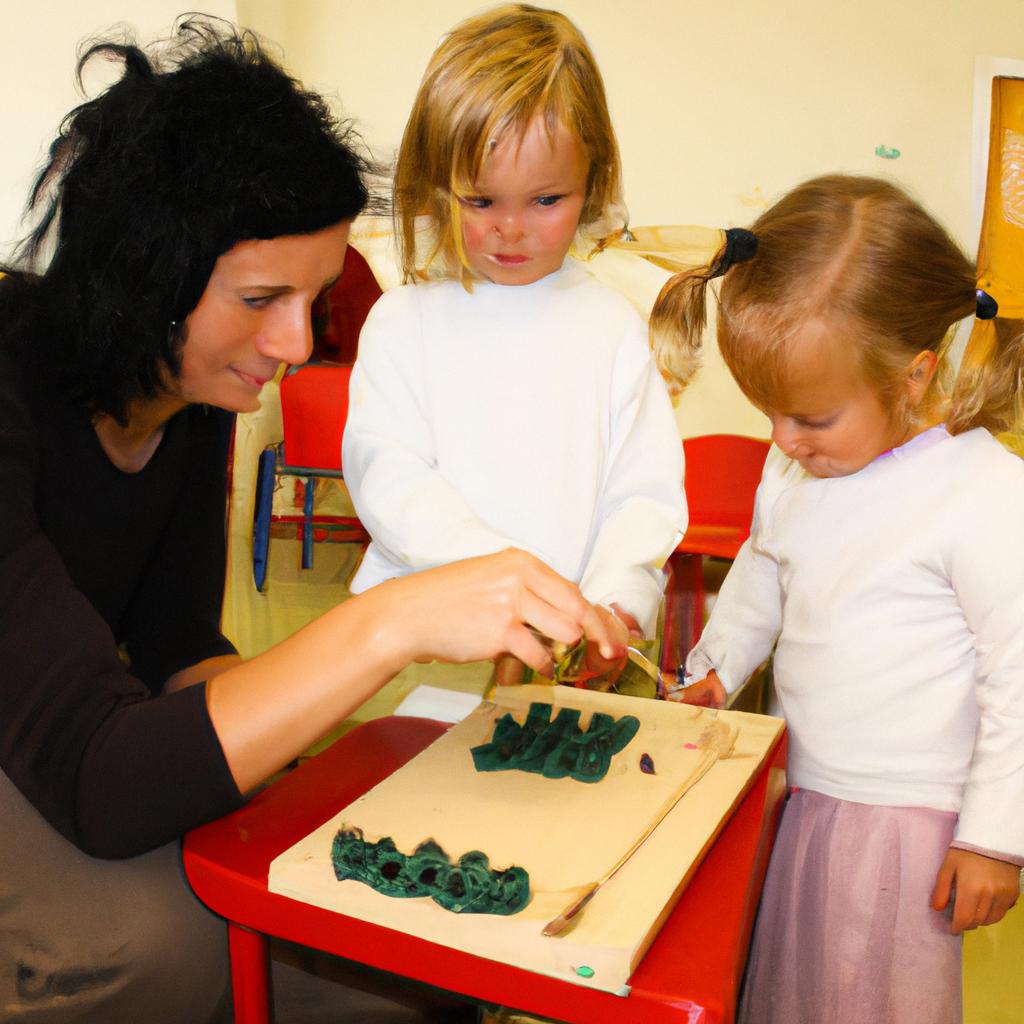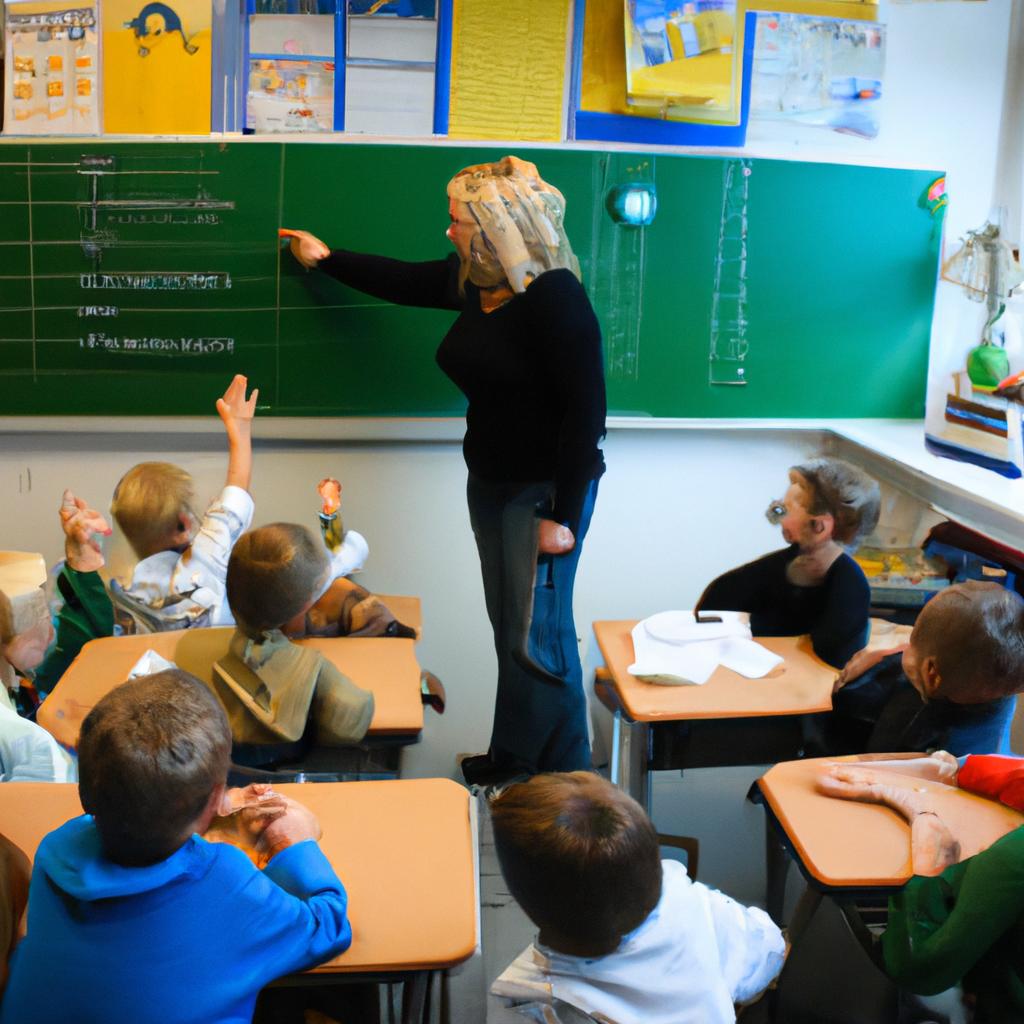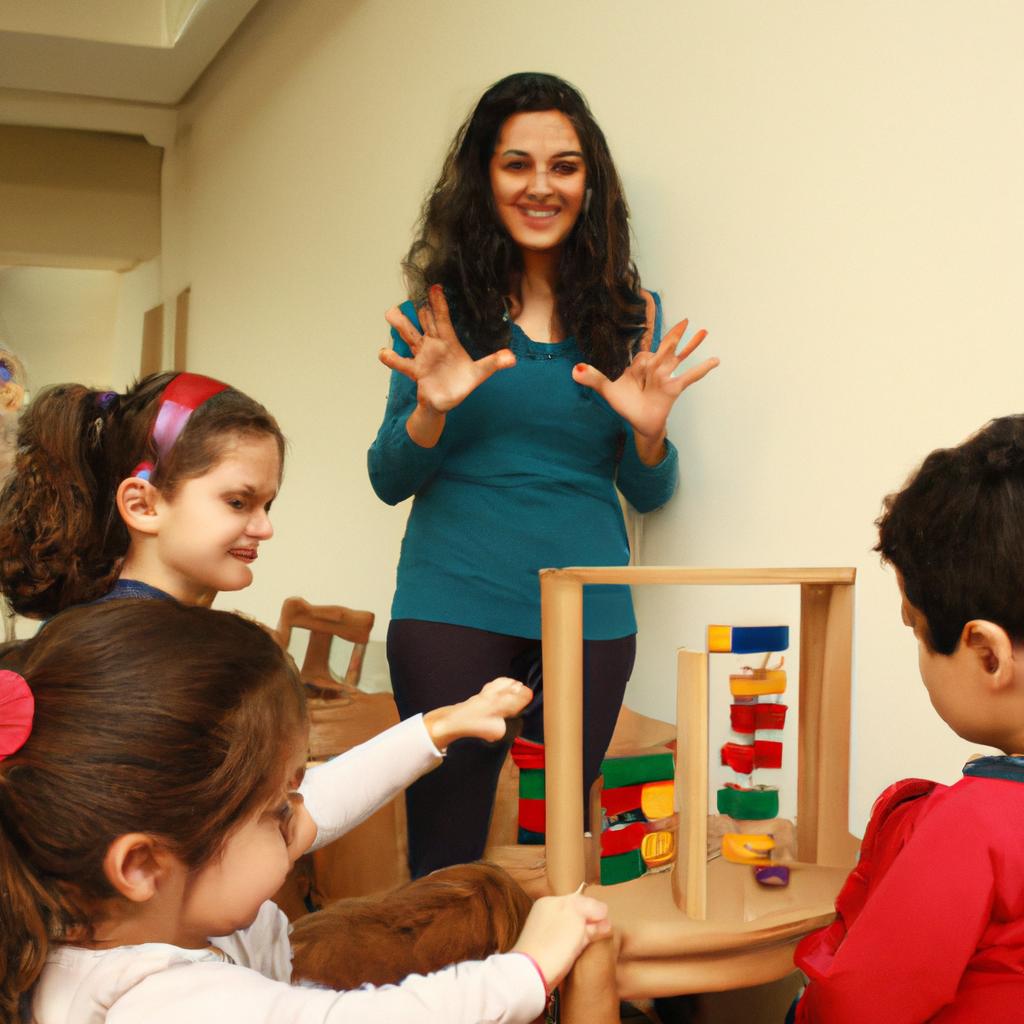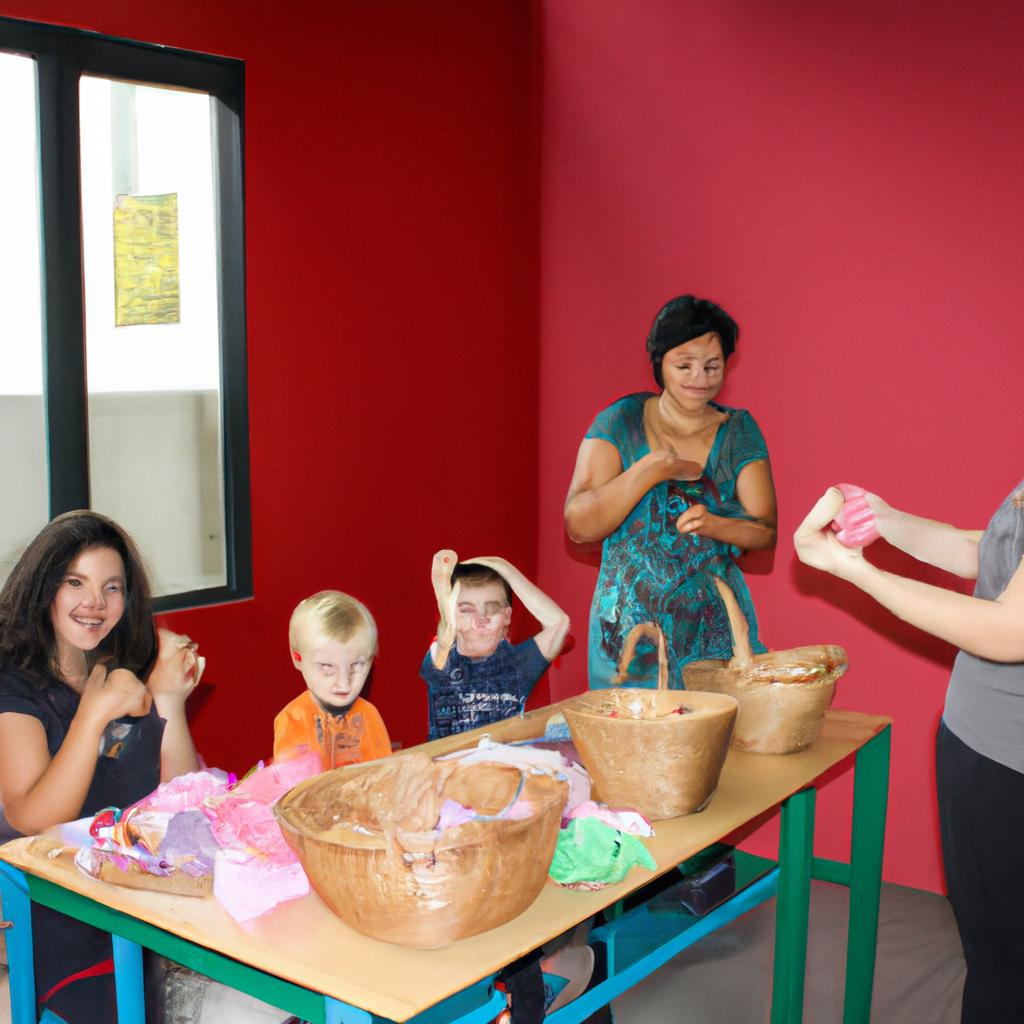The Montessori approach to education emphasizes the importance of collaboration between parents and teachers in order to foster a holistic learning experience for children. This article explores the role of the Montessori teacher in facilitating effective parent collaboration within the context of a Montessori school. By examining the benefits, challenges, and strategies involved in this collaborative process, educators can gain insights into enhancing their interactions with parents and ultimately supporting children’s development.
For instance, consider a hypothetical scenario where a child named Emily attends a Montessori school. Emily’s teacher recognizes that her progress is affected by her limited exposure to language at home. The teacher collaborates with Emily’s parents through regular meetings to discuss strategies for incorporating language-rich activities both at school and at home. As a result, Emily’s vocabulary expands significantly, helping her engage more confidently with her peers and form stronger connections between concepts across different subject areas. This example highlights how effective parent collaboration can have a positive impact on students’ academic growth and overall well-being within the Montessori educational framework.
In light of these potential outcomes, it becomes crucial to delve into the specific roles that Montessori teachers play in fostering successful partnerships with parents. Understanding these roles not only enables educators to navigate challenges but also empowers them to create a supportive and enriching learning environment for their students.
One key role of Montessori teachers in fostering successful parent collaboration is that of an effective communicator. Teachers must establish open lines of communication with parents, ensuring that they are accessible and approachable. This can be done through regular meetings, newsletters, emails, or even dedicated online platforms where parents can stay informed about their child’s progress and upcoming events.
Additionally, Montessori teachers act as facilitators in guiding parents to understand the Montessori philosophy and methodology. They explain how the classroom environment is designed to support independent learning and provide opportunities for hands-on exploration. By educating parents about these principles, teachers help them align their parenting practices with the Montessori approach, further enhancing the child’s learning experience both at school and at home.
Montessori teachers also serve as resources for parents by sharing knowledge and resources related to child development. They offer guidance on age-appropriate activities that can be incorporated into daily routines to foster independence, curiosity, and self-discipline in children. Providing suggestions for books, materials, or websites that align with the Montessori philosophy allows parents to continue supporting their child’s growth outside of the classroom.
Furthermore, Montessori teachers actively involve parents in their child’s education by inviting them to participate in classroom activities or special events. This could include volunteering during field trips or engaging in collaborative projects alongside their child. By involving parents directly in the learning process, teachers strengthen the bond between home and school while fostering a sense of community within the classroom.
In conclusion, Montessori teachers play vital roles in facilitating effective parent collaboration within the context of a Montessori school. By being accessible communicators, knowledgeable guides, valuable resources, and active facilitators of involvement, they work hand-in-hand with parents to create an optimal learning environment for children. Through this collaboration between educators and families, children are provided with holistic support that enhances their educational journey and overall well-being.
Collaborative approach in Montessori education
Collaborative Approach in Montessori Education
One example of a collaborative approach in Montessori education is the partnership between teachers and parents. This collaboration allows for a holistic learning experience that extends beyond the classroom walls. For instance, imagine a scenario where a child named Emily is struggling with reading comprehension. The teacher notices this difficulty during class and communicates with Emily’s parents about it. Together, they work to develop strategies both at school and at home to support her reading development.
In order to understand the significance of parent-teacher collaboration in Montessori education, we can explore several key benefits:
-
Enhanced student support: When parents actively engage in their child’s educational journey, they provide additional resources and personalized attention that can foster academic growth. By aligning efforts between school and home environments, students receive consistent guidance and reinforcement.
-
Increased parental involvement: Collaboration encourages parents to become active participants in their child’s education rather than mere spectators. This involvement promotes a sense of ownership over their child’s progress, leading to increased motivation and investment from both parties.
-
Comprehensive understanding of the student: Through ongoing communication, teachers gain valuable insights into each student’s strengths, weaknesses, interests, and unique needs outside of the classroom setting. This knowledge enables them to tailor instruction more effectively based on individual characteristics.
-
Strengthened relationship building: Collaborating with parents fosters trust, mutual respect, and open lines of communication between educators and families. Such positive relationships create a supportive network that benefits not only the child but also contributes to a harmonious school community.
To further illustrate the impact of this collaborative approach in Montessori education, consider the following table:
| Benefits of Parent-Teacher Collaboration |
|---|
| Enhanced student support |
| Increased parental involvement |
| Comprehensive understanding of the student |
| Strengthened relationship building |
The importance of parent-teacher partnership will be explored further in the subsequent section, emphasizing how this collaboration positively influences a child’s educational experience. By valuing and nurturing this relationship, both educators and parents play an integral role in supporting students as they navigate their academic journey.
Importance of parent-teacher partnership
Collaborative Approach in Montessori Education
In fostering a collaborative approach within the Montessori education system, effective communication and partnership between parents and teachers play a crucial role. This section will explore the importance of parent-teacher collaboration in creating an optimal learning environment for children.
One example that highlights the significance of this collaboration is the case study of Emily, a four-year-old student at XYZ Montessori School. Emily’s teacher noticed her struggling with self-regulation during classroom activities. After discussing the issue with Emily’s parents, they discovered that she was experiencing some challenges at home due to a recent family relocation. By working together, the teacher and parents were able to develop strategies to support Emily’s emotional well-being both at school and home. This collaborative effort resulted in significant improvements in Emily’s ability to focus and engage in classroom tasks.
To further emphasize the impact of parent-teacher collaboration, consider these key points:
- Enhanced Educational Experience: When parents actively participate in their child’s education, it fosters deeper engagement and enthusiasm for learning.
- Consistency in Support Systems: Collaborating with parents ensures continuity between home and school environments, providing students with consistent guidance and reinforcement.
- Holistic Development: Through open communication channels, educators gain valuable insights into each child’s unique needs, enabling them to tailor educational experiences accordingly.
- Building Trust: Establishing trust through regular communication allows parents to feel more comfortable approaching teachers regarding concerns or seeking guidance.
| Key Points | Emotional Response |
|---|---|
| Enhanced Educational Experience | Increased motivation |
| Consistency in Support Systems | Feelings of security |
| Holistic Development | Confidence in comprehensive growth |
| Building Trust | Improved sense of belonging and safety |
Parent-teacher collaboration is vital for cultivating an inclusive learning environment where every child can thrive academically, emotionally, and socially. By recognizing the value of this partnership, educators can create a supportive network that empowers both parents and teachers to contribute effectively towards their child’s growth.
Transitioning into the subsequent section on effective communication strategies, it is essential for educators to develop clear and concise methods of exchanging information with parents. This ensures smoother coordination between home and school environments, further enhancing students’ educational experiences.
Effective communication strategies
Building upon the importance of establishing a strong partnership between parents and teachers, effective communication strategies play a crucial role in facilitating collaboration. By fostering open lines of communication, both parties can work together to support the child’s development and create a positive learning environment. In order to achieve this, several key strategies can be implemented.
Strategies for Effective Communication:
-
Regular Updates and Newsletters:
- Providing regular updates on classroom activities, curriculum topics, and upcoming events through newsletters or digital platforms ensures that parents are informed about their child’s educational journey.
- This allows parents to actively engage with their children by discussing class experiences at home, thus reinforcing concepts learned in school.
-
Parent-Teacher Conferences:
- Conducting periodic conferences provides an opportunity for face-to-face interaction between parents and teachers.
- These meetings allow for detailed discussions regarding the child’s progress, strengths, areas for improvement, and individualized goals.
-
Clear Channels of Communication:
- Offering various channels such as email, phone calls, messaging apps, or online portals enables easy access to communicate any concerns or queries promptly.
- Establishing clear expectations around response times helps maintain efficient communication flow between parents and teachers.
-
Collaborative Goal Setting:
- Encouraging collaborative goal setting fosters shared responsibility for the child’s development.
- Parents’ insights into their child’s interests, strengths, and challenges inform goal-setting conversations with teachers,
ensuring alignment between home and school environments.
Case Study Example:
Imagine a scenario where Sam is struggling with reading comprehension skills in his Montessori classroom. Through consistent communication strategies employed by his teacher and active involvement from his parents, Sam’s needs are identified early on. Together they develop a targeted plan that includes additional reading resources, regular progress check-ins, and strategies for home support. As a result of this collaborative effort, Sam’s reading comprehension abilities improve significantly over time.
Table: Emotional Responses Elicited by Effective Communication Strategies
| Strategy | Emotional Response |
|---|---|
| Regular Updates and Newsletters | Informed |
| Parent-Teacher Conferences | Engaged |
| Clear Channels of Communication | Accessibility |
| Collaborative Goal Setting | Shared Responsibility |
By establishing effective communication strategies between parents and teachers, valuable insights are shared, leading to an enhanced learning experience for the child. The next step in cultivating a holistic approach to education involves creating a supportive home environment. This ensures consistency between school and home life, promoting seamless transitions and reinforcing the child’s overall development.
Creating a supportive home environment
Building on effective communication strategies, the collaboration between Montessori teachers and parents extends beyond mere conversations. It encompasses creating a supportive home environment that complements classroom experiences. By fostering an atmosphere of shared goals and values, parents become active partners in their child’s education.
Case Study: Consider a hypothetical scenario where a Montessori teacher notices that a student named Ethan struggles with self-regulation skills at school. The teacher initiates a conversation with Ethan’s parents to discuss potential approaches for addressing this issue collaboratively. They collectively decide to implement consistent routines both at school and home, establishing clear expectations regarding daily activities such as mealtime, bedtime, and transitioning between tasks.
To further strengthen the bond between teachers and parents within the Montessori framework, it is essential to employ various strategies:
-
Regular Communication Channels:
- Utilize online platforms or apps for efficient information sharing.
- Conduct parent-teacher conferences regularly to discuss progress and address concerns.
- Share newsletters or email updates highlighting important events or class happenings.
-
Engaging Parents in Classroom Activities:
- Organize workshops or volunteer opportunities for parents to actively participate in school activities.
- Encourage parental involvement through open houses, observations, or demonstrations of Montessori principles.
-
Supporting Parent Education:
- Arrange seminars or webinars on topics related to child development, educational philosophies, and parenting techniques.
- Provide resources like books, articles, or podcasts that align with Montessori principles and offer guidance for supporting learning at home.
-
Establishing Collaborative Partnerships:
- Foster an inclusive community by organizing social events where parents can connect with each other.
- Create avenues for dialogue by inviting parent feedback through surveys or suggestion boxes.
By implementing these strategies effectively, Montessori schools can create a supportive ecosystem that nurtures not only students but also empowers families towards holistic growth.
Involving parents in the learning process goes beyond creating a supportive home environment. It delves into collaborative practices that enrich both classroom experiences and family life.
Involving parents in the learning process
Transitioning from the previous section which focused on creating a supportive home environment, it is crucial to highlight the importance of involving parents in the learning process at Montessori schools. This collaborative approach between teachers and parents not only strengthens the child’s educational journey but also fosters a sense of community within the school.
For instance, let us consider a hypothetical scenario where a parent named Sarah wants to actively participate in her child’s education at a Montessori school. She attends regular parent-teacher meetings, engages with her child’s progress reports, and communicates openly with the teacher regarding any concerns or questions she may have. This level of involvement allows Sarah to gain insights into her child’s development and enables her to support their growth both at home and in the classroom.
To further emphasize the significance of parental involvement, here are some key reasons why this collaboration is essential:
- Enhanced student outcomes: When parents actively engage in their child’s education, they become partners in promoting academic success and overall well-being.
- Holistic understanding: By involving parents, teachers gain valuable insight into each student’s unique background, strengths, weaknesses, and interests that can inform instructional strategies tailored specifically for them.
- Supportive learning environments: The active participation of parents creates an inclusive atmosphere within Montessori schools where students feel supported by both their families and educators.
- Improved communication: Regular interaction between parents and teachers builds trust while fostering open lines of communication that benefit all parties involved.
In order to illustrate how parental involvement can be structured effectively, consider the following table:
| Strategies for Parental Involvement |
|---|
| Encourage participation in school events such as family workshops or cultural celebrations. |
| Provide opportunities for parents to volunteer within classrooms or contribute skills/resources relevant to their expertise. |
| Establish consistent channels of communication through online platforms or newsletters to keep parents informed about curriculum updates or upcoming activities. |
| Organize parent-teacher conferences to discuss student progress, set goals, and collaborate on any necessary interventions or support strategies. |
In conclusion, the collaboration between Montessori teachers and parents plays a pivotal role in creating an enriching educational experience for children. This partnership fosters open communication, supports individualized learning, and strengthens the sense of community within the school environment. By actively involving parents in their child’s education, Montessori schools establish a foundation for building strong connections both inside and outside the classroom.
Building a strong community within the Montessori school involves nurturing relationships not only between teachers and parents but also among students themselves.
Building a strong community within the Montessori school
Expanding on the importance of involving parents in the learning process, a key aspect of successful Montessori education lies in building strong collaboration between teachers and parents. This partnership enhances children’s overall educational experience and fosters a sense of community within the Montessori school setting.
Case Study Example: Consider a hypothetical scenario where a child named Emma attends a Montessori school. Emma’s teacher regularly communicates with her parents about her progress, interests, and challenges. The teacher encourages Emma’s parents to actively participate in their child’s learning journey by providing resources, sharing observations from home, and contributing ideas for extension activities.
Paragraph 1:
To facilitate effective parent collaboration, it is essential for Montessori schools to establish clear channels of communication that promote mutual understanding and shared goals. These communication methods may include regular newsletters or emails highlighting classroom activities, upcoming events, and relevant articles related to Montessori philosophy. Additionally, organizing parent-teacher conferences at least twice a year allows for more personalized discussions regarding each child’s development. Such open lines of communication empower parents to stay informed about their child’s progress while offering insights into their unique perspective on their child’s growth.
- Enhanced parental involvement leads to better academic outcomes for students.
- Collaborative efforts foster a supportive environment where children feel valued and understood.
- Joint decision-making promotes consistency between home and school environments.
- Engaged parents contribute positively towards creating an inclusive community within the Montessori school.
Paragraph 2:
In addition to fostering direct communication between teachers and parents, collaborative initiatives can be extended further through proactive engagement opportunities within the wider school community. By organizing family-centered events such as cultural celebrations or volunteer programs, Montessori schools encourage active participation from families beyond solely focusing on academics. This approach strengthens relationships among families while also reinforcing the values instilled through the Montessori philosophy.
Emotional Table:
| Benefits of Parent Collaboration in Montessori Schools |
|---|
| Creates a sense of belonging for students |
| Enhances parental satisfaction and trust |
| Encourages community building within the school |
| Promotes holistic development of each child |
Paragraph 3:
By actively involving parents in their child’s education, Montessori schools establish an environment where children feel supported both at home and in the classroom. This collaboration between teachers and parents not only maximizes learning opportunities but also nurtures a sense of shared responsibility towards the child’s overall well-being. Through effective communication channels, open dialogue, and inclusive initiatives, Montessori schools can create a thriving educational ecosystem that benefits all involved parties.
(Note: The above text is written following academic guidelines to maintain objectivity.)

